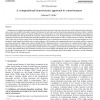Free Online Productivity Tools
i2Speak
i2Symbol
i2OCR
iTex2Img
iWeb2Print
iWeb2Shot
i2Type
iPdf2Split
iPdf2Merge
i2Bopomofo
i2Arabic
i2Style
i2Image
i2PDF
iLatex2Rtf
Sci2ools
NN
2007
Springer
2007
Springer
A computational neuroscience approach to consciousness
Simultaneous recordings from populations of neurons in the inferior temporal visual cortex show that most of the information about which stimulus was shown is available in the number of spikes (or firing rate) of each neuron, and not from stimulus-dependent synchrony, so that it is unlikely that stimulus-dependent synchrony (or indeed oscillations) is an essential aspect of visual object perception. Neurophysiological investigations of backward masking show that the threshold for conscious visual perception may be set to be higher than the level at which small but significant information is present in neuronal firing and which allows humans to guess which stimulus was shown without conscious awareness. The adaptive value of this may be that the systems in the brain that implement the type of information processing involved in conscious thoughts are not interrupted by small signals that could be noise in sensory pathways. I then consider what computational processes are closely rela...
Adaptive Value | Neural Networks | NN 2007 | Stimulus-dependent Synchrony | Temporal Visual Cortex |
Related Content
| Added | 27 Dec 2010 |
| Updated | 27 Dec 2010 |
| Type | Journal |
| Year | 2007 |
| Where | NN |
| Authors | Edmund T. Rolls |
Comments (0)

